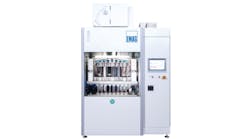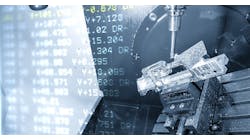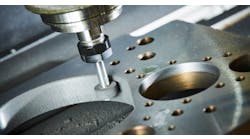Manufacturers are under pressure to change, to produce parts and systems that are smaller and lighter, and to do it with lower capital and operating costs – among other idealistic demands. Ideals are not always practical, but sometimes they become so.
In the first installment of this series, we described the distinctive process of electrochemical machining (ECM) and pulsed electrochemical machining (PECM), as well as its benefits. In the second installment, we explored various applications ECM and PECM. In this final installment, we will address how the future of manufacturing intersects with the future of electrochemical machining processes.
Industrial trends in part-miniaturization, advanced metal materials, and lower-cost near-net-shape manufacturing processes are placing new pressures on the manufacturing supply chain. In parallel, advances in electrochemical machining are providing new capabilities for manufacturers to respond to those new expectations.
The evolution of pulsed electrochemical machining can improve feature resolution, aspect ratio, and surface finish. New electrolyte and power supply technologies can enable PECM of valve or refractory metals.
Finally, software simulation tools can improve the quality and reduce the costs of PECM or ECM development.
Part miniaturization – Innovative engineers and product designers constantly strive for smaller and lighter components that will retain (or enhance) the intended functions or capabilities. The incentives for miniaturization are multi-faceted and include reduced material usage, improved efficiency or efficacy, and lower costs.
Miniaturization is a particular challenge in medical device manufacturing. A smaller surgical tool implies a smaller incision, so it will allow less invasive procedures, reducing the risk of surgery, and speeding up patient recovery times.
Similarly, a smaller and lighter implant will reduce stress on the orthopedic fixture site, may provide less irritation to surrounding tissue, and may provide longer implant viability with better patient outcomes.
Aerospace manufacturing sees part-miniaturization benefits too, where the design objective is closely tied to efficiency: Smaller parts reduce weight, which can increase range, decrease emissions, and decrease costs. Although the benefits of miniaturization are substantial, there are many engineering, design, and manufacturing challenges.
First and foremost, creating the feature sizes required by miniaturization is more difficult. Thin-walled geometries are more difficult to create with contact-based processes (tool pressure leading to vibration or distortion) and thermal methods (heat affected zones can add stress and deform thin walls). Consequently, manufacturing of thin walls with conventional methods typically requires more time and cost due to more finishing passes or lower thermal energy input, for example.
PECM provides an alternative approach. With no contact or thermal input, the low forces in PECM create thin-walls without a reduction in cycle time.
Pacemaker technology is an excellent representation of the challenges faced by medical device manufacturers to simultaneously miniaturize and improve the capabilities of parts. Sixty years ago, the first pacemakers involved a heavy, uncomfortable nickel-cadmium battery worn around the patient’s neck. Those devices were expected to last a maximum of six weeks.
Today, leadless pacemakers the size of a vitamin tablet are capable of lasting over a decade. However, producing modern pacemakers require advanced machining methods to cut specialty titanium alloys. Thin walls and precision features are required to locate the battery and circuitry within the case. These needs are still cost-constrained, and the manufacturing methods must be affordable.
Advances in PECM’s thin-wall capability, affordability in volume production, and ability to machine medical alloys like titanium make this process a particularly valuable tool in the future of pacemaker manufacturing.
Miniaturization also challenges the part function, whereby smaller features typically require tighter tolerances and better surface quality. Small turbine engines for unmanned aerial vehicles (UAVs, or drones) often have lower efficiencies because the tolerances and surface finishes need to scale with size, creating challenges for most manufacturing methods.
The <10 um (0.0004 in.) repeatability of the PECM process may be particularly useful in ensuring accurate part functionality.PECM's surface-finishing qualities should be considered as well: as low as 0.005 - 0.4 μm Ra (0.2-16 μin.), particularly valuable in miniature fluid flow applications (Voxel Innovations, Inc. data.)PECM’s precision manufacturing capabilities can play a vital role in part miniaturization across many manufacturing sectors. Various components in medicine, notably implants and surgical equipment, will continue to downsize, and forward-thinking manufacturers should consider incorporating PECM in their processes.
Advanced metal alloys – Historically, most metal alloys are created in furnaces by melting the constituent elements in a crucible, cooling them at a certain rate either in a form (casting) or into mill stock for processing via forging, rolling, or other hot or cold work methods.
However, advances in powder-metal production and consolidation techniques are making possible new generations of materials that cannot be created using traditional methods.
For example, spark-plasma-sintering or other powder consolidation techniques can be used to create new, high-entropy alloys or high-temperature material systems. These may be used in next-generation corrosion-resistant heat exchangers, rocket engine components, or thermal-energy conversion processes.
However, these powder consolidation methods may be limited to simple forms, requiring secondary machining, and these materials often have mechanical properties that are challenges for conventional machining methods.
Other materials like bulk metallic glasses or nano-structured metal matrix composites have impressive mechanical or thermal properties, but are abrasive to cutting tools, leading to higher manufacturing costs.
Electrochemical machining methods provide a unique alternative with relative immunity to the challenges of advanced metal materials. Metal-matrix composites may have elements that are non-dissolvable via ECM, however when the composite element is small in size (a growing industry trend), an ECM process will easily dissolve the metal material surrounding the composite particle without any extra wear. The unique properties of valve or refractory metals have presented historical challenges to the use of ECM.
Yet, new advances in PECM by Voxel Innovations and others make it possible to machine these unique material classes.
Finally, the speed at which PECM can machine a material is relatively constant across many elements and alloys. Therefore, as advanced metal materials are introduced, the removal rate of PECM will be minimally affected.
Near-net manufacturing – Producing a component close to the final shape can reduce costs and improve material utilization. Methods like forging, stamping, and casting are the most common, however metal-injection molding and additive manufacturing are providing new, near-net shape manufacturing processes. However, these techniques have some drawbacks too, and as component complexity increases more near-net techniques will require secondary processing or machining.
In An Introduction to Electrochemical Machining Part 2, we explained how PECM can be a complementary process to 3D printing (aka, additive manufacturing or AM.)
An important trend in industrial metal AM is the transition from prototyping to volume production. In this transition, some of the additive manufacturing disadvantages related to cost, surface finish, and tolerance are becoming more pronounced. Rough surfaces that result from support structures or downskin areas may require precise finishing to achieve the required functionality without any fatigue life or crack inspection challenges.
One way to reduce the manufacturing costs for powder bed processes is to increase layer thicknesses or adopt faster melting parameters, while other AM techniques include adopting production speeds that are orders of magnitude faster but come at the expense of resolution.
New developments in finish machining for metal AM parts with PECM at companies like Voxel Innovations will quickly address both surface finish and form tolerance, helping AM to achieve a better cost-performance in volume production. The same benefits of PECM can be applied to other near-net-shape products, like castings with thin walled or intricate features, which can significantly increase the scrap rate.
For example, a thin-walled airfoil on a printed or cast turbine vane may be processed better with PECM as a secondary operation, rather than accepting a thicker wall feature or high scrap rates with a near-net-shape operation. As near-net-shape manufacturing methods like AM continue to develop and high-volume projects become commonplace, PECM in particular may benefit as a cost-effective, secondary process for these high-quality components.
Kirk Gino Abolafia is the Technical Marketing Manager for Voxel Innovations, Inc., Raleigh, N.C., a pioneer in pulsed electrochemical machining. View Voxel Innovations’ education portal or contact the company with any questions about PECM.








